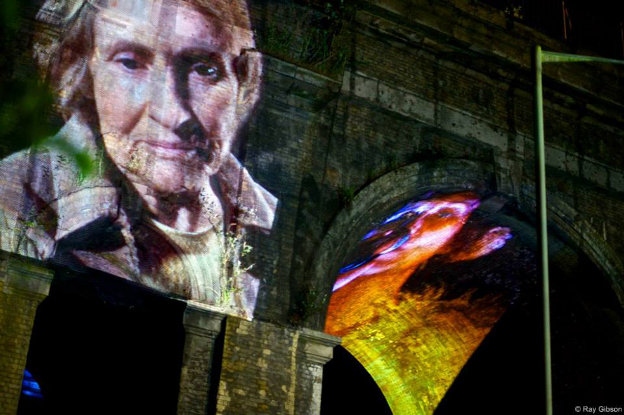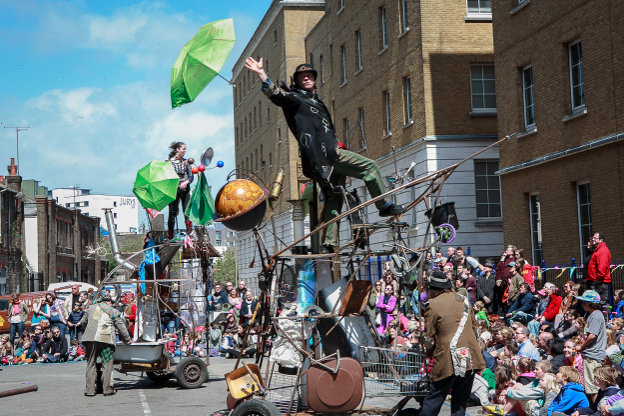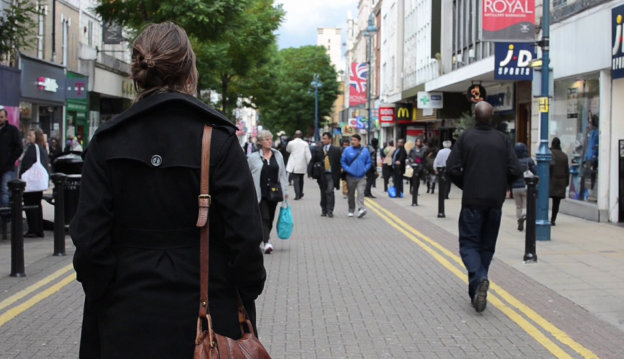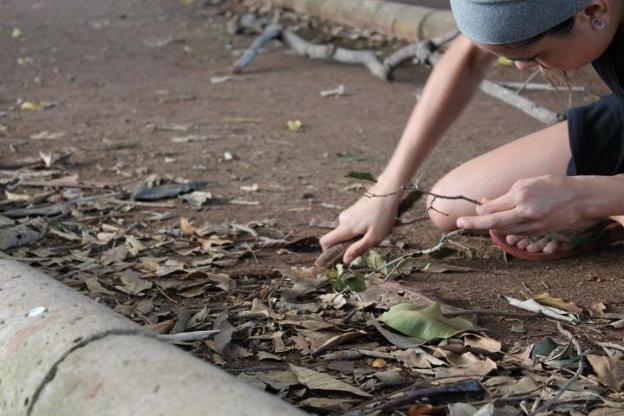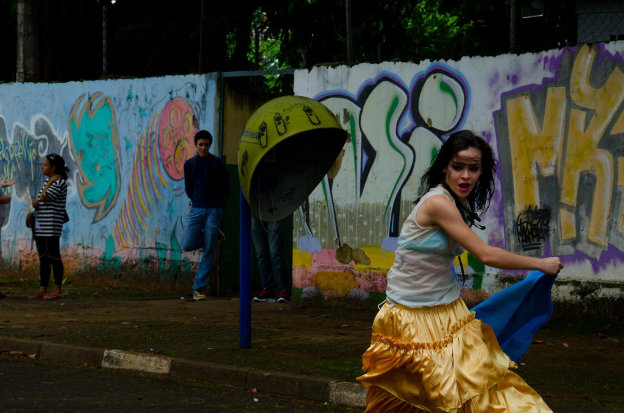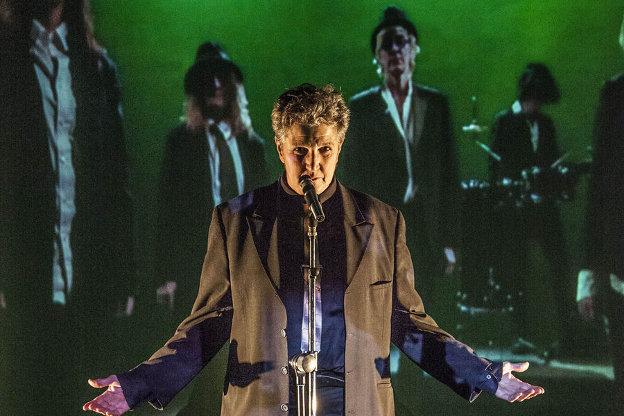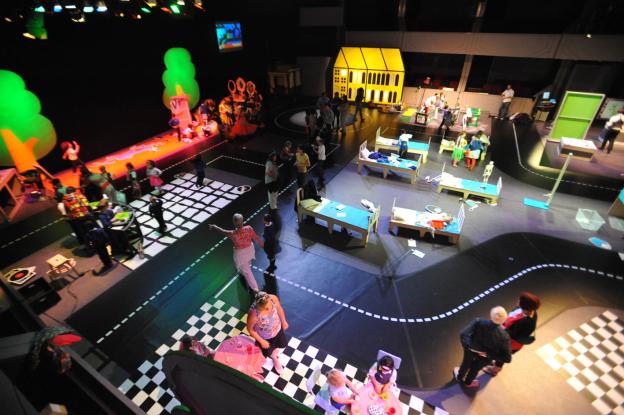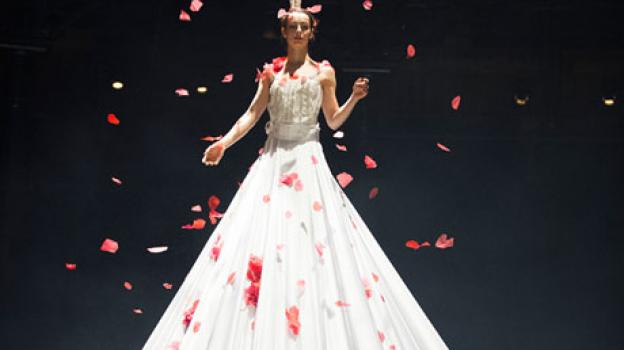Brighton Festival has a long-standing commitment to what was once called ‘street theatre’ or ‘street arts’ but which now tends to be called ‘outdoor arts’. Which is – or at least in Total Theatre’s opinion should be – work that is presented in public spaces, free to audiences and ideally unticketed, so that the passer-by drawn into the action is as key a part of the audience body as the arts-savvy person who has booked a ticket in advance. I may be an old-fashioned girl, but both as an artist working in this field and as a critic and commentator, I stick firmly to the above definitions as vital to the essence of street or outdoor or whatever-we-call-it work. Of course streets arts, like any artform or mode of practice, moves and changes and embraces new ways of working – but to me it feels important to hang on to what makes the essence of the form…
So, bearing this in mind, ticketed shows such as Blast Theory’s Fixing Point, and the interesting looking (but sadly unsampled) Burn the Curtain show The Adventures of Don Quixote by Bicycle, don’t count for the purposes of this article, which is focusing on outdoor arts / street theatre work that upholds the ethos of free-to-audience presentation in a public space.
Above shows aside, what we have left on the Brighton Festival Outdoor programme that fits the bill is a very mixed bag of work: the Same Sky Children’s Parade opened the Festival as is the tradition; two visual arts pieces set in public space were on show throughout the duration, The Blue Route by Kaarina Kaikkonen, which saw the Brighton Clocktower adorned in clothing (a twin to the Finnish artist’s beautifully blue indoor installation at Fabrica), and what we could call an intervention in public space called Under the Shadow of the Drone by James Bridle, a line drawing of the shadow of a drone plane painted on the street (presented as part of HOUSE festival); there was one big international street arts booking, KompleXKaphaurnüM’s Figures Libres; and every weekend at least one work on show from the Without Walls programme – a presentation of new outdoor arts work by UK artists.
And so to Without Walls, ‘a consortium of festivals dedicated to commissioning, presenting and supporting new outdoor work’. This consortium includes Brighton Festival and Norfolk and Norwich Festival (who kick off the outdoor season in May), Greenwich & Docklands, Stockton International Riverside Festival, and Mintfest – amongst others across the land. The programme is managed by Xtrax, an organisation that has been at the forefront of street arts in the UK for many decades, and each year a number of new outdoor works are commissioned and produced at the participating festivals throughout the year (and hopefully beyond). Not all the festivals programme all of the work – this year’s Brighton Festival saw five of the ten commissions presented.
First seen, in the opening week of the festival, was Mercurial Wrestler’s Magna Mysteria. Or at least, I did my best to see it! It’s a kind of magical mystery tour, in which you sign up at a beautifully crafted fairground sideshow fortune-telling booth, receive a sort-of tarot card (mine was The Sisters – there’s also a Policeman, a Siren, and a Magician), and then await instructions, which arrive some time later by text. You are referred to a website that gives some background information on the characters, and you are then – over a number of days – sent on a quest to find these characters and to glean, through this fragmented narrative, the fate of the missing sister. Indeed, more than ‘glean’ – you become a participant in the creation of the story (which is a kind of post Angela Carter / Erin Morgenstern tale of shady alternative reality happenings in Victorian music halls). I very much enjoy my second-day encounter with the Policeman (in a back alley, inevitably), which I find more inspiring than the first brief encounter with the forlorn remaining sisters, and I am sad not to meet the other characters and see the piece through to its conclusion – but putting aside three or four days in a row to participate in a few 30 minute bursts of performance just wasn’t feasible for me in this busy May festival month. It’s a lovely idea, but very much work-in-progress. Though it was fatally flawed as presented, I was engaged and interested, and would like to see Magna Mysteria reworked and developed into something that manages to balance the need for audience commitment with the demands of daily life.
Second up, a few days later (that is, on the festival’s second weekend), was Rag & Bone’s Bone Yard Tales, a cautionary tale of existential angst and dawning environmental awareness, set in a no-man’s-land junkyard in which ‘beauty is in the eye of the magpie’ – Steampunk meets Steptoe and Son, perhaps? Directed by Periplum’s Damian Wright, there are definite shades of that company’s earlier outdoor work here, perhaps in the way in which the rhythmical text delivery – a would-be epic poem about finding and killing your inner demons – is balanced with the live music and physical action, which takes place mostly atop and below a trio of moveable three-wheeled towers. The characters (‘Rag’ and ‘Bone’ and their entourage) are performed with gusto – I particularly like Periplum stalwart Ben Phillips as Bone and the onstage saxophonist (who I believe may well be the company’s resident composer, Tim Hill). In a story focusing on two characters in limbo, forever locked in the pursuit of absurd tasks in a strange other-world, there’s an inevitable Beckett-esque feel to it all, which personally I think could be built upon a lot more – it is all rather too lightweight at the moment. I like the household object graveyard look of it all, and I enjoy the animation of the giant dragon-like creature that emerges from the rubbish, but the final demon-slaying (or not?) scene is a bit of an anti-climax. The moments of audience interaction also fall a little flat: people wearing red, say, or who are tall or small, are hauled into the performance space for no discernible good reason. It’s all enjoyable enough for the most part, but again this show feels most definitely ‘in progress’.
Which brings up an interesting point about street arts. Work can of course be scripted and rehearsed, objects can be built and manipulated, physical action devised and developed indoors – but inevitably there comes a point when it all has to be placed together outdoors, and placed in interaction with an audience. So in many ways there is no way to rehearse a street show other than by just getting out there and doing it. This has always been known and accepted as inevitable – a show in its first year is trying out, and in its second outdoor season it hopefully starts to settle into what it will be. In the context of dedicated street theatre /outdoor arts festivals, this all works fine as there is an audience expectation of seeing work at various stages of development in one setting, and developing shows have the buffering of stronger and better shows around them. The problem with the Without Walls programme seen in Brighton is that these undeveloped shows are being presented as finished works within the context of a major international arts festival. Each was showcased at separate runs throughout the month, and each was often the main or only outdoor arts event on that day, thus attracting audiences with high expectations.
The piece that suffered most from this dynamic was Bad Taste’s Faust. Presented on a Saturday and Sunday evening at central Brighton sites, the show attracted big crowds – most of whom couldn’t see what was happening in the performance space for a lot of the time. This was partly because one of the key elements of the show, breakdancing, happens at floor level and just isn’t visible from the back of a large crowd, but also because for some reason the whole show was played to stage-left, so that all the hundreds of people sitting or standing on the other side of the square (including me) spent most of the time looking at someone’s back. This odd staging seemed to be because of the lighting choices – an enormous floorlamp highlighting this small off-centre dance area – which meant that quite apart from having a back view, everyone stage-right had the light beaming directly into our eyes for the duration. The show itself is a very simplified and abstracted dance version of the Faust story, set in a Roaring 20s prohibition era speakeasy. It features an all-male cast who Charleston and Lindy Hop with great gusto, alongside the aforementioned breakdancing (which is, you know, good – but nothing we can’t see every weekend on the seafront at Brighton), and some nifty physical action with fire – blazing cocktails, and a dance-fight tag match in a burning boxing ring, for example. The show’s currently around 25 minutes long, and after a rather abrupt ending, the cast return for an encore that is move-for-move a full repeat of the ‘Sing Sing Sing’ multi-dance-rhythm routine that is the highlight of the show, bumping the running time up to a little over 30 minutes. It feels slight, for sure.
Much more successful, for this reviewer anyway, was A High Street Odyssey, a new outdoor piece by Inspector Sands (a usually-indoors company, previous winners of a Total Theatre Award for Hysteria at the Edinburgh Festival Fringe, and subsequently presented at the London International Mime Festival). Without Walls have been positively encouraging companies who don’t usually work outdoors to apply for commissions, and although there are different views on this – many established street arts companies feeling that commissioning money could go to people choosing to work in this sector, who know what they are doing – in this case, I think it has been a good commissioning choice. Not that it’s perfect – like all the other Without Walls shows reflected on above, there is a way to go. But in this case, less of a way – there’s already a lot in place that is very good.
As the show name implies, A High Street Odyssey seeks out the epic in the everyday. ‘What histories, what mysteries, lie behind our pedestrianised shopping centres?’ ask Inspector Sands. ‘Who were Mr Boot and Mr Smith?’ Who indeed… The show is cleverly structured – each new town setting means new research about the neighbourhood, and new material to be weaved into the performance text, but the ubiquitous nature of the high street environment being commented upon means that there is material that can be transposed from site to site. There is also plenty of general reflection on human evolution (‘we’ve risen out of the sea and walked on the moon…’) and the paths that have been trodden many times before by man and beast (‘Once there were trees here – is that a wild boar under that garden bench outside Robert Dyers?’) that would be re-usable in any setting. As for the site-specific touches – yes, some nice little references to bar staff who are students of philosophy, and the provenance of the name ‘Hove’, but it feels as if a trick has been missed in the research as there are very many wondrous things about Hove that don’t get referenced – I can’t remember if famous resident Laurence Olivier (who allegedly coined the phrase ‘Hove, actually’ when asked where he lived in Brighton) gets a mention, but I don’t think he did. A scene in which passers-by are commented on feels a little too safe and nervous of offence – and I should also say that I was waiting to learn why Claire was so into accessories, but I never did get to find out. That aside, I very much enjoyed the clever use of headphones, with a soundtrack that we suddenly realise with a jolt has a live element; the low-key performances and interventions – the rubbish picker that we suddenly realise is in on the game, the man loitering with a pram who turns out to be the sound engineer, the lady who steals people’s croissants in a coffee shop and later is seen dancing wildly in a shop window, the busker whose rendition of Wonderwall gets hijacked by that batty lady to become a full-on poetic rant on consumerism: ‘I want a Blackberry, and a well-fitting bra, and a car… and three kids, or maybe two will do…’ This finale is the one point in the piece where passers-by get properly drawn into the action – and if I have one major criticism it would be that it would be good if Inspector Sands could think through how people who haven’t booked in to this free but ticketed event (and therefore don’t have a pair of headphones) could perhaps be brought into the action in some kind of secondary manner along the way, rather than be excluded. After all, a pack of people walking down a street together wearing headphones is going to attract attention! A High Street Odyssey is created by a very capable theatre company, and although they have a fair amount to learn about working outdoors, and how to create truly site-responsive work, they are highly talented writers and performers and I can imagine that this is a piece that will grow and grow with each performance.
The one Without Walls commission (or co-commission, at least) presented at Brighton Festival that I haven’t commented on here is OCM’s Audible Forces, an Aeolian (that is, wind-powered) sound piece curated/created by Max Eastley, and featuring sound-making structures built with and by seasoned outdoor sound art creators such as Jony Easterby, Kathy Hinde and Dan Fox. This piece, being an ambient installation work, and being by artists highly experienced in making outdoor work, seems to stand apart from the other shows discussed above. That and the fact that I haven’t a great deal to report on as, due to inclement weather, I got blown back from the seafront when I made an attempt to go and see/hear the piece on the opening weekend of Brighton Festival. Sadly, it was only in place for that one weekend, so I didn’t get a second chance – but it was somehow enough to just appreciate it from afar and know it was there, whistling and sighing, oblivious to whether it had human attention or not… I’ll make another attempt at the Greenwich & Docklands Festival in June!
Audible Forces aside, these Without Walls shows were presented at key city centre sites over successive weekends: Magna Mysteria had a Sunday finale in the first weekend of May (although unadvertised as you had to have followed the trail), Bone Yard Tales was presented in the daytime and on both evenings of the second weekend, A High Street Odyssey filled the daytime slot andFaust both evenings of the third weekend. On the final weekend of the festival (Friday 24 and Saturday 25 May) the evening slot was occupied by the French company KompleXKarphanaüM, with the UK premiere of their large-scale promenade work Figures Libres. This I sadly didn’t get to see as I was at the Norfolk and Norwich Festival for that weekend, but by all accounts it was an example of the sort of big, bold and inspiring street arts presentation that Brighton Festival is known for. Seasoned street theatre producer Karen Poley described it as ‘Epic and transformative. They did an amazing job of spreading out projections along the entire length of the route so everyone felt at the heart of the performance… amazing strength in combining intimacy and scale.’ Other knowledgeable street arts folks mentioned the extensive and efficient use of video and sound technologies, and the well-handled interactive elements, including the use of text messaging. Veteran street arts photographer Ray Gibson described it as one of the best street shows he’d ever seen, adding ‘The whole event transformed a part of the city barely visited by most Brightonians into a visual delight.’
I’m glad that there was one work of this quality programmed into the festival, but a number of questions arise for me. First, that it seems unbalanced to place new undeveloped work like Bone Yard Tales and Bad Taste’s Faust in a similar high-profile standalone weekend evening slot as a company with the experience and clout of KompleXKarphanaüM. I’d prefer to see the Without Walls commissions presented across one weekend, and flagged up far more strongly in the programme as newly commissioned work. I’d also, of course, like to see more top quality street arts work presented in Brighton Festival. It shouldn’t come down to just one properly developed work of scale by an experienced company carrying the torch for outdoor arts in what is, after all, England’s largest arts festival. There is always the familiar question of where the UK work of scale and quality is. The answer to this is complex. Large-scale and spectacular work by the likes of Periplum and Wired Aerial Theatre has been presented by Brighton Festival in past years, and perhaps the argument is that there just isn’t anything currently available of a similar scale and ambition that hasn’t already been programmed, although there is also the possibility that the opportunity to fund or commission new large-scale work from established UK street artists is being overlooked. We can note here that two South East based established street theatre companies, World Famous and Ragroof Theatre, went out of business in the past year, due to a lack of the kind of long-term company development funding support (as opposed to project-based support) that they would need to continue. Periplum have also not been in a position to create the kind of large-scale work like The Bell(previously seen at Brighton Festival) that made their name, and have, of late, focused on smaller scale and more intimate work. And perhaps there is currently a trend, in this country anyway, away from spectacle and towards work that engages audiences in a different way – although KompleXKarphanaüM (whose previous work PlayRec I saw at a previous Brighton Festival) are an example of a company who manage to combine spectacle and intimacy very cleverly, and integrate current trends for promenade, site-responsive and immersive theatre into their work very successfully.
In conclusion: great to see the variety of new work presented under the Without Walls banner, but the context in which it was presented at Brighton Festival raises questions. It would be great to see a range of work of different scales by experienced street theatre/outdoor art makers, from the UK or from elsewhere, presented in tandem with this fledging work.
The Without Walls shows seen at Brighton Festival now go on to tour to other festivals throughout the UK. They are joined by five other new outdoor works on the programme, from Les Enfants Terribles, Pif Paf, Motionhouse Dance, Tilted Productions, and Candoco.
For more about Without Walls, and the touring dates of all the works commissioned for 2013 see their website.
Brighton Festival ran 4 – 26 May 2013.

